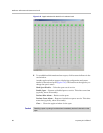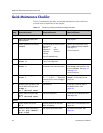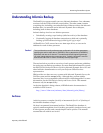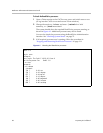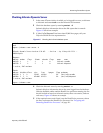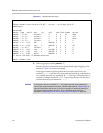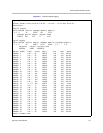
ReadiVoice Administration & Maintenance Guide
94 Proprietary & Confidential
In the event of database corruption, a crash, or catastrophic disk failure, you
can restore the database from the most recent archive tape to the state it was in
when the archive was created. Logical logs (see next section) then enable you
to recover the transactions that took place after the most recent archive.
How often should you archive your database? It depends on the size and
activity level of your system, whether you have the optional disk mirroring
feature, and your comfort level with regard to risk.
We recommend, for most circumstances, nightly archives. The command
ontape -s -L 0
creates a full level 0 archive on the archive tape device. The
process prompts for user input, so you must deal with this in the
crontab
file
if you want to schedule the task.
Each morning, remove the tape, label it, and replace it with the next one. Use
ten tapes (or fourteen if you operate on weekends) in rotation. Consider
rotating the oldest five (or seven) to an off-site facility for protection against an
extreme disaster at your site.
Combining the most recent nightly archive with the subsequent logical logs
(on the logical log backup tape and/or on disk), you have a very high
probability of recovering all database information right up to the point of
failure. Even if the logical logs on disk are lost and the logical log backup tape
fails, you lose only one day’s data. If an archive tape fails, you can still recover
all data by using the previous day's archive tape together with the logical logs.
The procedures in “Daily Maintenance Tasks” on page 97 assume that you’re
archiving the database nightly.
Logical Logs
Informix records all database transactions in its logical log files as soon as
they’re complete. By default, your system is set up to use thirty log files of 1
Mbyte each. You can change the number and size of the log files in
/usr/informix/onconfig.conferencenow
. The logical logs provide a
complete record of all database activity.
When a log is full, Informix starts writing to the next one. If all logs are full,
Informix halts. Therefore, the logical logs must be backed up to tape (or to
/dev/null
) and marked as available again on an ongoing basis.
If your database crashes, you can restore it to the point of the last archive using
the most recent archive tape. Then, you can recover all subsequent
transactions using the logical log tape together with the log file on disk that
was being used at the time of the crash. This recovers all data up to and
including the last completed transaction.
Caution!
Validate your archives and, from time to time, test your ability to restore from them.
Tapes wear out over time. Label them with the date of first use and replace them
every six months.





